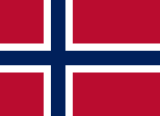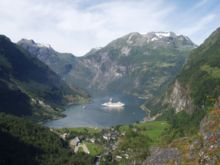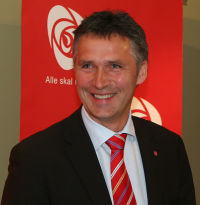Norway
Norway (official name The Kingdom of Norway, Norwegian: Kongeriket Norge or Kongeriket Noreg) is a country in Northern Europe. Norway has a population of 4,681,100 (2007 estimate)[1], and an area of 385,155 km² (148,746 mi²). The capital is Oslo.
Geography
Norway occupies the western parts of the Scandinavian peninsula, and is bordering Sweden i the east. It also borders Finland and Russia in the northeast. Norway has a land border of 2,542 km (1,580 miles).
Norway has a continental coastline of 25,148 km (15,626 miles). It borders the North Sea and the Norwegian Sea in the west, the Skagerrak in the south and the Barents Sea in the north. Norway's long coastline is famous for its fjords.
The landscape of Norway is dominated by mountains, and much of the country is barren (32% of continental Norway is above the tree line). However, Norway's valleys are relatively fertile.
History
Norway consisted of petty kingdoms until it was united in 872, when Harald Fairhair was victorious at the Battle of Hafrsfjord and became the first king of Norway.
During the Norse era, Norwegian explorers discovered and colonized Iceland and Greenland, and even reached Newfoundland in present-day Canada. Norse settlers established colonies in parts of Ireland and Britain, and the infamous Vikings were a constant menace to Western Europe. The Norsemen were engaged in trade with distant places such as the Middle East.
Christianity came to Norway in the late 900s. After Saint Olafs victory in the Battle of Stiklestad in 1030 Norway was mostly Christianized, even though paganism still existed in remote areas for some time.
The Black Plague came to Norway in 1349, and hit Norway hard. From Bergen it spread rapidly to other parts of Norway, and decimated the population. The mortality is estimated to be 40-50%.[2] The high death toll left Norway vulnerable to foreign influence, and Norway joined the Kalmar Union in 1523. Norway remained in a union with Denmark until 1814.
Protestantism was introduced in Denmark-Norway in 1537, and the king took control over church property and affairs. King Christian III of Denmark and Norway declared Lutheranism as the official religion of the realm, and after absolutism was introduced in the 17th century, all clerics were appointed by the King. Evangelical-Lutheran protestantism is still the official religion of Norway, with the King as the head of the official Church of Norway.[3][4]
Denmark-Norway sided with Napoleon during the Napoleonic Wars, and Norway was ceded to Sweden. Norway did not accept this, and declared independence and adopted a constitution in 1814. However, after a short war, Norway was forced into a personal union with Sweden.
Norway became independent in 1905, when the union with Sweden was dissolved peacefully. A Danish prince was chosen as King of Norway, and became Haakon VII of Norway.
During World War II, Germany invaded Norway on April 9, 1940. The southern parts of Norway quickly fell to the invading forces, but the war saw some allied success in the northern theater. The Norwegian forces surrendered on June 10, after French and British forces had to withdraw to fight in the campaign on continental Europe. The German occupation lated until May 1945, with the support of a puppet government lead by Vidkun Quisling.
Norway joined NATO in 1949. Norway has had referendums for joining the European Union twice (1972 and 1994), both times with a narrow victory for the opposers. Norway is a member of the European Free Trade Association, and is thus associated with the EU through the European Economic Area and other treaties.
Politics
Norway is a parliamentary monarchy. The current king is Harald V, and the prime minister is Jens Stoltenberg of the Labor Party. Mr. Stoltenberg leads a coalition with the Center Party and the Socialist Left Party.
The legislative branch consists of the parliament, Stortinget (approximate translation: “The Great Assembly”). The parliament can not be dissolved, and the representatives are elected by popular vote for a four year term. The current president of the parliament is Thorbjørn Jagland of the Labor Party, and the vice-president is Carl I. Hagen of the Progress Party.
The executive is nominally lead by the King, but his powers are mainly symbolic. The parliamentary system ensures that the government needs the confidence of the Storting, and the King will usually ask the leader of the largest party or block to form the government. Mr. Stoltenberg's coalition has been in power since the fall of 2005. Other key ministers are the finance minister, Kristin Halvorsen, and the foreign minister, Jonas Gahr Støre.
The judicial branch is lead by the Supreme Court (“Høyesterett”). The first level is the city court or county court (“Byretten” and “Herredsretten”), and the mid level (court of appeal) is called “Lagmansretten.”
Administrative divisions
Norway is divided into 19 counties (“fylker”), and 431 municipalities (“kommuner”). The capital, Oslo, is both a county and a municipality (the same applied the second largest city, Bergen, until 1972).
Counties
Demographics
Languages
Religion
References
- ↑ Focus on Population. Statistics Norway. Retrieved on 2007-05-24.
- ↑ Oeding P. The black death in Norway. Tidsskrift for Den norske lægeforening. 1990
- ↑ The Norwegian Embassy in the UK. Religion in Norway. Retrieved 2007-05-24
- ↑ The Church of Norway (2007-04-30). The current state–church-process in Norway. Retrieved 2007-05-24
Bibliography
- Archer, Clive (2005). Norway Outside The European Union: Norway and European Integration from 1994 to 2004. Routledge. ISBN 0415282799. – Covers the relationship between the EU and Norway, and how the EEC influences Norway and the EU
- Sammingsen, Ingrid (1980). Norway to America, A History of Migration. University of Minnesota Press. ISBN 0816610002. – Discusses Norwegian immigration to the United States from 1825 to 1980. Dr. Semmingsen was the founder of Norwegian research of migration to the U.S.


